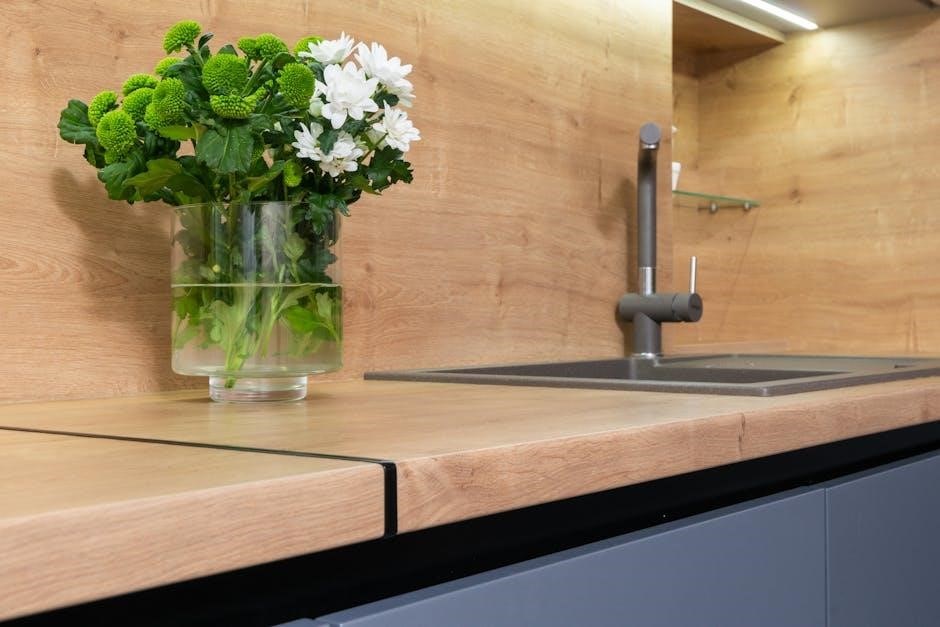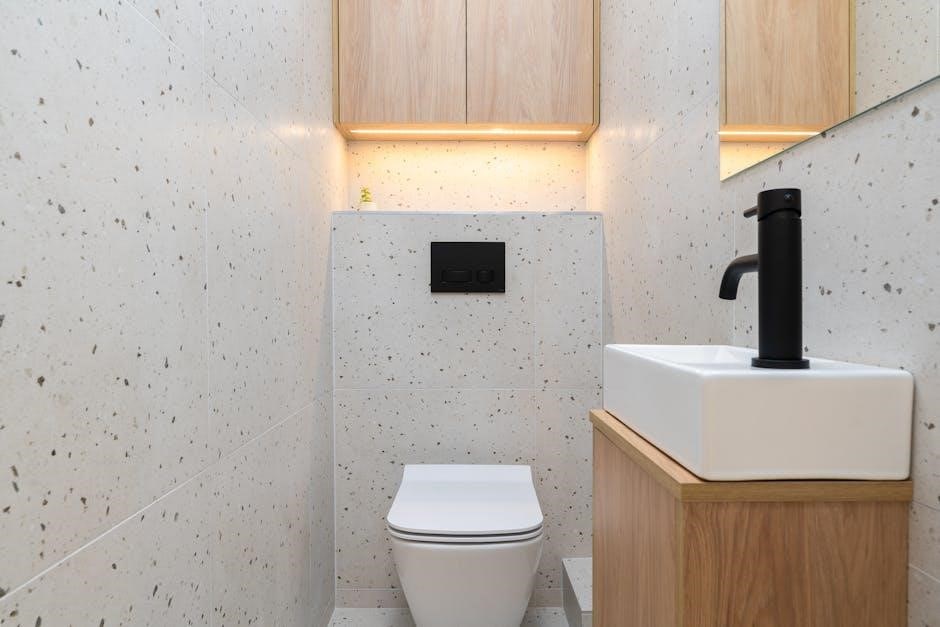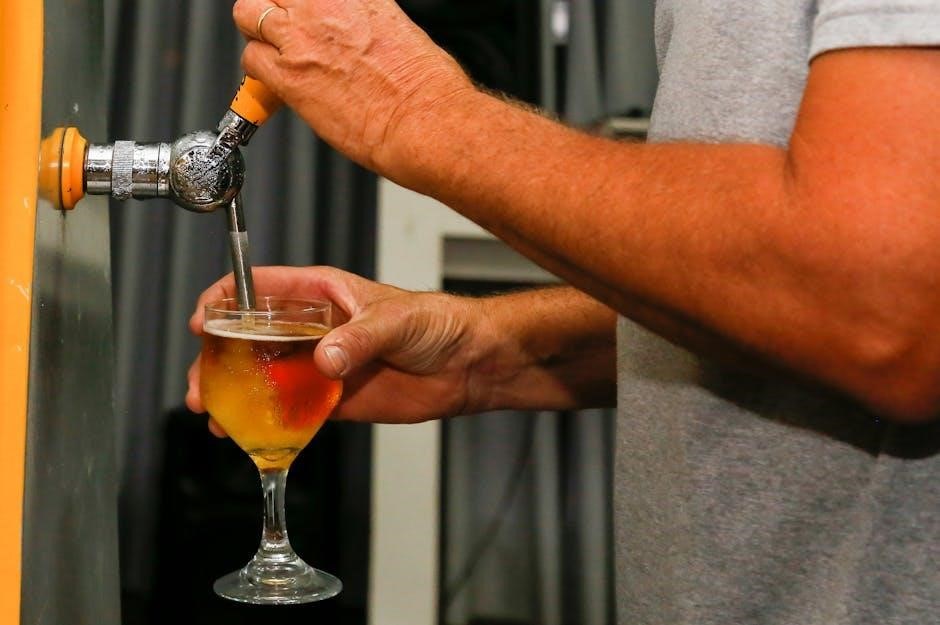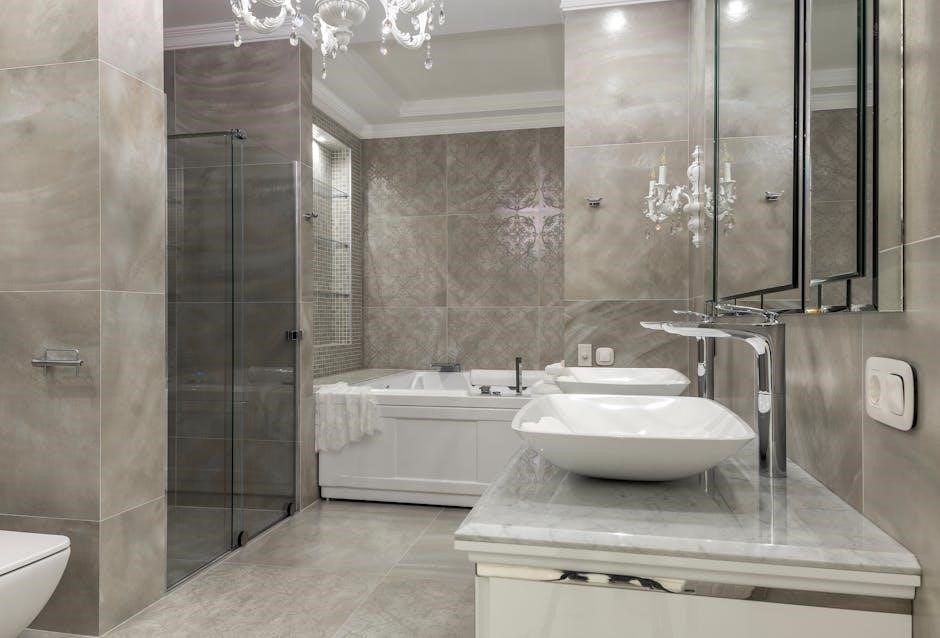Understanding Billi Tap fault codes is crucial for diagnosing and resolving issues promptly․ This guide provides insights into common fault codes, troubleshooting steps, and maintenance tips to ensure optimal performance and longevity of your Billi Tap․ By addressing these aspects, users can identify problems early, potentially avoiding costly repairs and ensuring continuous access to hot and chilled water․ This comprehensive overview is designed to empower users with the knowledge needed to maintain their Billi Tap effectively, whether through simple fixes or advanced diagnostics․

How to Identify Billi Tap Fault Codes
Identify fault codes by checking the tap’s display or consulting the user manual․ Flashing lights or error messages often indicate specific issues, guiding troubleshooting efforts effectively․
Understanding Fault Code Indicators
Fault code indicators on Billi Taps are designed to provide clear and immediate feedback about system issues․ These indicators often appear as flashing lights or specific error messages on the tap’s display․ Each code corresponds to a particular problem, such as temperature fluctuations, flow rate issues, or filter blockages․ By recognizing these indicators, users can quickly pinpoint the root cause of the malfunction․ For instance, a blinking red light may signal a water temperature issue, while a steady orange light could indicate a filter needing replacement․ Understanding these visual cues is essential for effective troubleshooting and ensures that the tap operates efficiently․ Regular monitoring of these indicators can help prevent minor issues from escalating into more severe problems․ This section will delve into the meanings behind these indicators, enabling users to address faults promptly and maintain their Billi Tap’s optimal performance․
Methods to Retrieve Fault Codes
Retrieving fault codes on a Billi Tap can be done through several straightforward methods․ The most common approach is to check the tap’s digital display, which shows error codes when a fault occurs․ Additionally, users can access the service menu by pressing a specific sequence of buttons, usually found in the user manual․ For models without a display, fault codes may be indicated by flashing lights, with patterns corresponding to specific issues․ Consulting the official Billi Tap user guide or PDF manual is highly recommended, as it provides detailed code explanations and retrieval procedures․ If the codes are unclear, contacting Billi support or visiting their official website can provide additional guidance․ These methods ensure users can quickly identify and address issues, minimizing downtime and ensuring smooth operation․ Regularly checking for updates or new codes is also advisable․
Interpreting Fault Code Meanings
Interpreting Billi Tap fault codes involves understanding the specific issues each code represents․ Codes like E1, E2, E3, and E4 indicate distinct problems, such as water temperature fluctuations, flow rate issues, clogged filters, and power supply problems․ Referencing the official Billi Tap PDF manual or user guide is essential, as it provides detailed explanations for each code․ Additionally, recognizing patterns in the codes can help users diagnose issues more effectively․ For example, E1 often relates to temperature malfunctions, while E3 signals a blocked filter․ If a code’s meaning is unclear, consulting the manual or contacting Billi support is recommended․ Accurate interpretation ensures timely resolutions, preventing minor issues from escalating․ Regularly reviewing the manual helps users become familiar with common codes, enhancing their ability to address faults independently․ This knowledge empowers users to maintain their tap’s performance and extend its lifespan․ By understanding these codes, users can address problems confidently and efficiently, ensuring optimal functionality of their Billi Tap․

Common Billi Tap Fault Codes
Billi Taps often display fault codes like E1, E2, E3, and E4, indicating issues such as water temperature problems, flow rate inconsistencies, clogged filters, or power supply faults․
Fault Code E1: Water Temperature Issues
Fault Code E1 typically indicates a problem with the water temperature in your Billi Tap․ This could mean the water is either too hot or not reaching the desired temperature․ Common causes include malfunctioning thermostats, faulty temperature sensors, or issues with the heating element․ In some cases, incorrect temperature settings or a disrupted water supply might also trigger this code․ To resolve E1, start by checking the temperature settings to ensure they are configured correctly․ Next, inspect the temperature sensor for any blockages or damage․ If the issue persists, it may be necessary to replace the thermostat or heating element․ Always refer to the official Billi Tap manual or contact a professional for complex repairs to avoid further complications․
Fault Code E2: Flow Rate Problems
Fault Code E2 on your Billi Tap signifies issues with the water flow rate, meaning the tap is not dispensing water as intended․ This could be due to a clogged filter, low water pressure, or blockages in the plumbing system․ A faulty flow sensor or scale buildup might also trigger this error․ To resolve E2, begin by inspecting and replacing the water filter if necessary․ Check the water supply lines for kinks or obstructions and ensure proper water pressure․ Descale the tap if hard water is an issue in your area․ If these steps don’t resolve the problem, it may indicate a malfunctioning flow sensor or internal component, requiring professional intervention․ Regular maintenance, such as filter replacements and system checks, can help prevent future flow rate issues and maintain optimal performance of your Billi Tap․
Fault Code E3: Filter Clogged
Fault Code E3 indicates that the water filter in your Billi Tap is clogged, restricting water flow and potentially affecting temperature control․ A clogged filter can occur due to sediment, limescale buildup, or debris accumulation over time․ Ignoring this issue may lead to reduced water flow, inconsistent temperatures, or even complete stoppage of water dispensing․ To resolve E3, replace the filter with a compatible Billi Tap filter․ Ensure the new filter is properly installed and aligned to maintain optimal performance․ Regularly cleaning or replacing the filter every 6-12 months, depending on usage and water quality, can prevent this fault from recurring․ Additionally, check for any blockages in the filter housing and ensure all connections are secure․ A well-maintained filter ensures consistent water quality and flow, keeping your Billi Tap functioning smoothly․
Fault Code E4: Power Supply Issues
Fault Code E4 indicates a problem with the power supply to your Billi Tap․ This could be due to a faulty power cord, tripped circuit breakers, or issues with the electrical connection․ To resolve E4, first, check the power cord for any visible damage or wear․ Ensure the tap is properly plugged into a functioning power outlet․ If the issue persists, inspect the circuit breaker or fuse box to confirm the power supply is stable․ Resetting the tap by turning it off and on may also resolve the issue․ If these steps fail, contact a licensed electrician to check for underlying electrical problems․ Addressing E4 promptly is essential to prevent further malfunctions and ensure safe operation of your Billi Tap․

Troubleshooting Billi Tap Faults
Troubleshooting Billi Tap faults involves identifying error codes and addressing issues like power supply problems or clogged filters․ Start by checking the display for fault codes, then follow specific steps to resolve each issue․ For example, E1 to E4 codes often relate to temperature, flow rate, or power supply․ Verify connections, reset the tap if needed, and consult the user manual or contact support for advanced fixes․ Regular maintenance, such as filter changes, can prevent many faults․ If unresolved, professional assistance may be required to ensure safe and efficient operation of your Billi Tap․ Early detection and prompt action are key to minimizing downtime and extending the lifespan of your unit․
Basic Troubleshooting Steps
Start by identifying the fault code displayed on your Billi Tap․ Codes like E1 to E4 indicate specific issues, such as temperature or flow rate problems․ Check the power supply and ensure all connections are secure․ For water-related faults, inspect the filter and clean or replace it if clogged․ Reset the tap by switching it off and on again․ If the issue persists, refer to the user manual or contact Billi Support for further guidance․ Regularly checking and maintaining your tap can prevent many faults․ Always follow safety precautions and manufacturer instructions to avoid further complications․ These basic steps can help resolve common issues efficiently and keep your Billi Tap functioning smoothly․
Advanced Diagnostic Techniques
For persistent issues, advanced diagnostic techniques can help pinpoint underlying problems․ Start by consulting the Billi Tap user manual to interpret fault codes accurately․ Use specialized tools, such as multimeters, to test water temperature sensors or flow rate sensors for accuracy․ Inspect internal components like solenoids and heating elements for damage or malfunction․ Isolate the issue by temporarily bypassing components, such as the filter, to determine if it is the source of the fault․ Perform a system reset after repairs to ensure proper functionality․ Utilize diagnostic software, if available, to analyze system performance․ If issues remain unresolved, consult a professional technician; These advanced methods provide deeper insights into complex faults, ensuring effective resolution and restoring optimal performance to your Billi Tap․
Resetting the Tap After Repair
After completing any repair on your Billi Tap, resetting the system ensures proper functionality․ Start by turning off the power supply at the mains for at least 30 seconds․ This allows the system to fully reset․ Turn the power back on and check for any remaining fault codes․ If the issue has been resolved, the tap should operate normally․ Run a few cycles of hot and cold water to test performance․ If the fault persists, consult the user manual or contact Billi support for further assistance․ Resetting after repair is crucial to clear any stored error codes and ensure the tap functions optimally․ Always follow the manufacturer’s guidelines for resetting procedures to avoid further complications․

Maintenance Tips to Prevent Faults
- Regularly replace water filters to prevent clogging and ensure clean water flow․
- Check and tighten all water connections to avoid leaks and pressure issues․
- Descale the tap periodically to remove mineral buildup and maintain efficiency․
- Clean the exterior regularly to prevent dirt and grime accumulation․
- Ensure stable power supply to avoid electronic malfunctions and fault codes․
Regular Filter Changes
Regular filter changes are essential for maintaining the performance and longevity of your Billi Tap․ Over time, filters can become clogged with sediment, debris, and impurities, leading to reduced water flow and potential fault codes such as E3 (Filter Clogged)․ It is recommended to replace filters every 6 to 12 months, depending on usage and water quality․ Neglecting this maintenance can result in decreased efficiency, inconsistent water temperature, and even system failures․ Always use genuine Billi replacement filters to ensure compatibility and optimal performance․ Before replacing, turn off the power and water supply to avoid any leaks or damage․ Refer to your user manual for specific instructions tailored to your model․ Regular filter changes are a simple yet crucial step in preventing faults and ensuring your Billi Tap operates smoothly for years to come․

Checking Water Connections
Regularly inspecting water connections is vital for ensuring the optimal performance of your Billi Tap․ Fault codes such as E2 (Flow Rate Problems) or E4 (Power Supply Issues) can often be traced back to issues with water connections․ Over time, connections may develop leaks, become loose, or accumulate mineral buildup, which can disrupt water flow and pressure․ To check the connections, turn off the power and water supply to the tap․ Visually inspect all hoses, fittings, and valves for signs of damage, corrosion, or blockages․ Ensure all connections are secure and replace any worn or damaged components․ Using genuine Billi parts is recommended to maintain system integrity․ Regular checks can prevent minor issues from escalating into major faults, ensuring consistent hot and chilled water delivery․ This simple maintenance step plays a key role in preserving the longevity and efficiency of your Billi Tap․

When to Call a Professional
If your Billi Tap displays severe fault codes or issues persist after basic troubleshooting, it’s essential to contact a certified professional․ Complex diagnostics or internal repairs require specialized expertise to avoid further damage․ Don’t hesitate to seek help for irreversible faults or advanced technical problems to ensure your tap functions safely and efficiently․
Recognizing Severe Faults
Severe faults with your Billi Tap often manifest through persistent error codes, complete system shutdowns, or visible damage․ If the tap displays recurring codes like E4 (power issues) or E3 (clogged filters) despite attempts to resolve them, it indicates a deeper problem․ Other signs include water leaks, unusual noises, or the tap not turning on at all․ These issues typically require professional intervention, as they may involve internal components or electrical problems․ Ignoring severe faults can lead to further damage or safety hazards, such as electrical malfunctions or water damage․ Always prioritize calling a certified technician if you notice any of these critical symptoms to ensure your tap operates safely and efficiently․

How to Contact Billi Support
If you encounter issues with your Billi Tap that cannot be resolved through troubleshooting or maintenance, contacting Billi Support is essential; Visit the official Billi website and navigate to the support section․ There, you can find a contact form, email address, or phone number to reach their customer service team․ For urgent matters, calling their hotline is recommended․ Ensure you have your tap’s model number and any relevant fault codes ready to expedite assistance․ Billi Support typically operates Monday to Friday, 9 AM to 5 PM, so plan your inquiry accordingly․ Their team is trained to address complex issues and provide tailored solutions, ensuring your tap returns to optimal functionality․

Billi Tap User Resources
Access official PDF guides and manuals on the Billi website for detailed instructions and fault code explanations․ Join online forums and communities for peer support and solutions․
Official PDF Guides and Manuals
The official Billi Tap PDF guides and manuals are essential resources for understanding fault codes and troubleshooting․ These documents, available on the Billi website, provide detailed explanations of each fault code, including their meanings and potential solutions․ They also offer step-by-step instructions for resolving common issues, ensuring that users can address problems confidently․ Additionally, the manuals include maintenance schedules and tips to prevent future faults․ By referencing these official materials, users can ensure they are following recommended procedures, minimizing the risk of further issues․ For those seeking comprehensive guidance, these PDF resources are indispensable tools for maintaining and repairing their Billi Tap effectively․
Online Forums and Communities
Online forums and communities are valuable resources for Billi Tap users seeking advice on fault codes and troubleshooting․ Platforms like ResearchGate and dedicated forums on the Billi website offer spaces to share experiences and solutions․ Users often discuss common issues, such as fault codes E1, E2, E3, and E4, and provide actionable advice․ These communities are particularly helpful for resolving issues without professional assistance․ Many forums also include links to PDF guides and manuals, ensuring users have access to official documentation․ Additionally, independent plumbing and appliance forums often feature discussions about Billi Taps, offering real-time support and troubleshooting tips․ Engaging with these communities can save time and help users address faults efficiently․ Active participation in these forums fosters a supportive environment for resolving issues and sharing knowledge․

Future of Billi Tap Fault Code Technology
The future of Billi Tap fault code technology is poised for significant advancements, focusing on enhanced diagnostic capabilities and user-friendly features․ Smart integration with home automation systems could enable real-time monitoring and proactive issue detection․ Predictive maintenance, powered by AI, may anticipate faults before they occur, reducing downtime․ Additionally, augmented reality (AR) interfaces could guide users through troubleshooting steps visually․ The development of more detailed and accessible fault code databases, like the Billi Tap fault codes PDF, will empower users with clearer insights․ These innovations aim to streamline maintenance, improve efficiency, and elevate the overall user experience․ As technology evolves, Billi Tap fault code systems will likely become more intuitive and interconnected, ensuring seamless operation and minimal disruptions for users․
